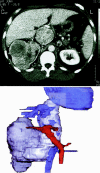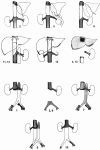Resection of the inferior vena cava for neoplasms with or without prosthetic replacement: a 14-patient series
- PMID: 11176131
- PMCID: PMC1421207
- DOI: 10.1097/00000658-200102000-00014
Resection of the inferior vena cava for neoplasms with or without prosthetic replacement: a 14-patient series
Abstract
Objective: To review the outcome of resection of the suprarenal or infrarenal inferior vena cava (IVC) and possible indications for prosthetic replacement.
Summary background data: Involvement of the IVC has long been considered a limiting factor for curative surgery for advanced tumors because the surgical risks are high and the long-term prognosis is poor. Prosthetic replacement of the IVC is controversial.
Methods: The authors retrospectively reviewed a 7-year series of 14 patients who underwent en bloc resection including a circumferential segment of the IVC. The tumor was malignant in 12 patients and benign in 2. The resected segment of the IVC was located above the kidneys in eight patients and below in six. Resection was performed without extracorporeal circulation in all patients.
Results: In all but one patient, IVC resection was associated with multivisceral resection, including extended nephrectomy (n = 8), major hepatic resection (n = 3), digestive resection (n = 3), and infrarenal aortic replacement (n = 2). Prosthetic replacement of the IVC was performed in eight patients cases and was more common after resection of a suprarenal (6/8) than an infrarenal segment of the IVC (2/6). One patient died of multiorgan failure. Major complications occurred in 29% of patients. Symptomatic complications of prosthetic replacement occurred in one patient (acute postoperative thrombosis, successfully treated by surgical disobstruction). Graft-related infection was not observed. Marked symptoms of venous obstruction developed in three of the six patients who did not undergo venous replacement. In patients undergoing surgery for malignant disease, the estimated median survival was 37 months and the actuarial survival rate was 67% at 1 year.
Conclusion: Multivisceral resection including a segment of IVC is justified to achieve complete extirpation in selected patients with extensive abdominal tumors. Prosthetic replacement of the IVC may be required, particularly in cases of suprarenal resection. It is a safe procedure with a low complication rate and good functional results.
Figures




References
-
- Kearney GP, Bedford Waters W, Klein LA, et al. Results of inferior vena cava resection for renal cell carcinoma. J Urol 1981; 125: 769–773. - PubMed
-
- Sarti L. Total prosthetic transplantation of the inferior vena cava, with venous drainage restoration of the one remaining kidney on the graft, successfully performed on a child with Wilms’ tumor. Surgery 1970; 67: 851–855. - PubMed
-
- Kieffer E, Berrod JL, Chomette G. Primary tumors of the inferior vena cava. In: Surgery of Veins. Bergan JJ, Yao JST, eds. New York: 1985:423–443.
-
- Brabrand K, Soreide JA. Adrenal cortical carcinoma with invasion into the inferior vena cava. Br J Surg 1987; 74: 598–599. - PubMed
MeSH terms
LinkOut - more resources
Full Text Sources
Research Materials

